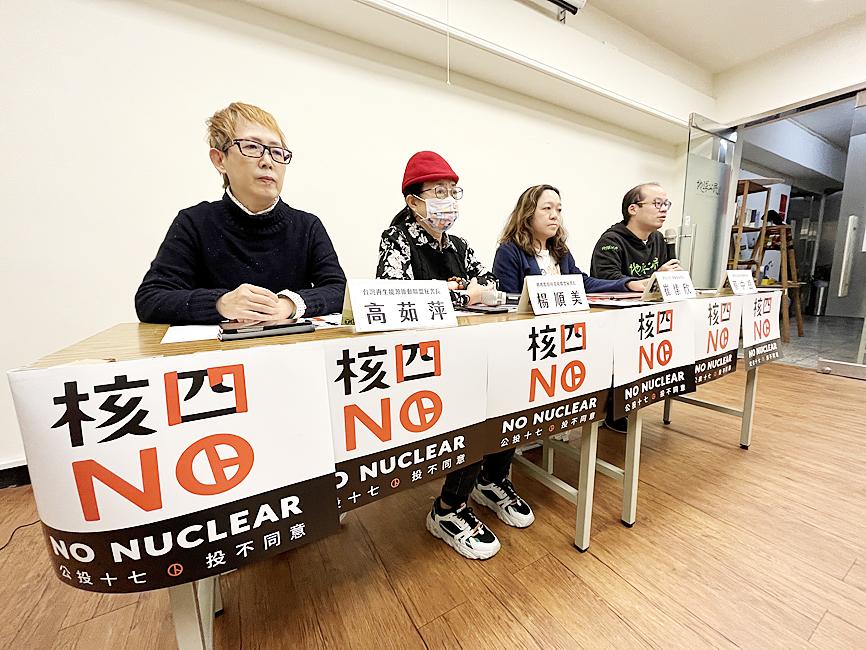A majority of voters yesterday rejected a proposal to restart construction on the mothballed Fourth Nuclear Power Plant in New Taipei City’s Gongliao District (貢寮), with 4,262,451 votes against and 3,804,755 in favor.
Initiated by nuclear power advocate Huang Shih-hsiu (黃士修), the referendum asked voters: “Do you agree that the Fourth Nuclear Power Plant should be activated for commercial operations?”
The plant was most recently mothballed in 2015 when Ma Ying-jeou (馬英九) of the Chinese Nationalist Party (KMT) was president, one year after former Democratic Progressive Party (DPP) chairman Lin I-hsiung (林義雄) staged a hunger strike against the plant’s construction.

Photo: CNA
The referendum has garnered the most “no” votes among the four referendums held yesterday, Citizen of the Earth, Taiwan deputy executive director Tsai Chung-yueh (蔡中岳) told a news conference in Taipei yesterday.
The result showed that voters are concerned about the plant’s location in an earthquake-prone area and nuclear waste disposal, he said.
While another referendum in 2018 indicated mayority support for nuclear power, yesterday’s vote showed that Taiwan would continue its efforts to become “a nuclear-free homeland,” Tsai said, thanking voters for lending support for energy transition.

Photo: CNA
“Finally, the Fourth Nuclear Power Plant [is] history,” Green Citizens’ Action Alliance secretary-general Tsuei Su-hsin (崔愫欣) said.
The plan to construct the plant goes back to the 1980s, when the nation was under martial law, she said, adding that the plant has been a symbol in the nation’s political struggles.
The government should start making plans to demolish the unfinished plant, and review its effect on the nation’s budget and how to use the site, Tsuei said.
Huang wrote on Facebook that he regretted that the referendum had failed.
The government would never tackle the nuclear waste issue, and burned fuel rods would probably be permanently stored in New Taipei City, Huang said, referring to storage sites at two other plants in Shihmen (石門) and Wanli (萬里) districts.
Without the Fourth Nuclear Power Plant, the government would burn more coal, leading to more air pollution in central and southern Taiwan, as well as more deaths, Huang added.
The nation’s transition to renewable energy sources is behind schedule, and Taiwan might face serious electricity shortages, he said.
The ruling and opposition parties should jointly consider extending the licenses of Wanli’s Guosheng Nuclear Power Plant and Pingtung County’s Ma-anshan Nuclear Power Plant, he said.
Alternatively, Taiwan could follow the global trend and treat nuclear power as “green” energy, Huang said, suggesting the construction of a small modular reactor at the site of the Fourth Nuclear Power Plant.
The Atomic Energy Council in 2017 approved Taiwan Power Co’s (Taipower) plan to decommission Shihmen’s Jinshan Nuclear Power Plant within 25 years.
Decommissioning of four units at the Guosheng and Ma-anshan plants would begin before 2025, the council said.
Another referendum in 2018 prompted the government to nullify Article 95-1 of the Electricity Act (電業法), which stipulated that all nuclear power plants should go offline by 2025.
However, the government has not made any attempts to change the timetable for the decommissioning of nuclear reactors since the 2018 vote.
Last year, about 12.7 percent of the nation’s electricity was generated by nuclear plants, 40.8 percent by gas-fired units, 36.4 percent by coal-fired units, 5.8 percent by renewable sources and the rest by mixed sources, data on Taipower’s Web site shows.

Three Taiwanese airlines have prohibited passengers from packing Bluetooth earbuds and their charger cases in checked luggage. EVA Air and Uni Air said that Bluetooth earbuds and charger cases are categorized as portable electronic devices, which should be switched off if they are placed in checked luggage based on international aviation safety regulations. They must not be in standby or sleep mode. However, as charging would continue when earbuds are placed in the charger cases, which would contravene international aviation regulations, their cases must be carried as hand luggage, they said. Tigerair Taiwan said that earbud charger cases are equipped

UNILATERAL MOVES: Officials have raised concerns that Beijing could try to exert economic control over Kinmen in a key development plan next year The Civil Aviation Administration (CAA) yesterday said that China has so far failed to provide any information about a new airport expected to open next year that is less than 10km from a Taiwanese airport, raising flight safety concerns. Xiamen Xiangan International Airport is only about 3km at its closest point from the islands in Kinmen County — the scene of on-off fighting during the Cold War — and construction work can be seen and heard clearly from the Taiwan side. In a written statement sent to Reuters, the CAA said that airports close to each other need detailed advanced

Tropical Storm Fung-Wong would likely strengthen into a typhoon later today as it continues moving westward across the Pacific before heading in Taiwan’s direction next week, the Central Weather Administration (CWA) said. As of 8am, Fung-Wong was about 2,190km east-southeast of Cape Oluanpi (鵝鑾鼻), Taiwan’s southernmost point, moving westward at 25kph and possibly accelerating to 31kph, CWA data showed. The tropical storm is currently over waters east of the Philippines and still far from Taiwan, CWA forecaster Tseng Chao-cheng (曾昭誠) said, adding that it could likely strengthen into a typhoon later in the day. It is forecast to reach the South China Sea

WEATHER Typhoon forming: CWA A tropical depression is expected to form into a typhoon as early as today, the Central Weather Administration (CWA) said yesterday, adding that the storm’s path remains uncertain. Before the weekend, it would move toward the Philippines, the agency said. Some time around Monday next week, it might reach a turning point, either veering north toward waters east of Taiwan or continuing westward across the Philippines, the CWA said. Meanwhile, the eye of Typhoon Kalmaegi was 1,310km south-southeast of Oluanpi (鵝鑾鼻), Taiwan’s southernmost point, as of 2am yesterday, it said. The storm is forecast to move through central